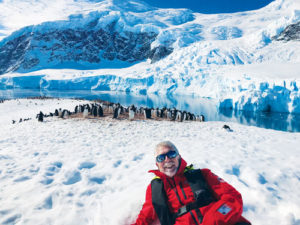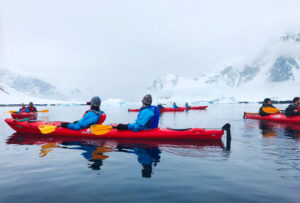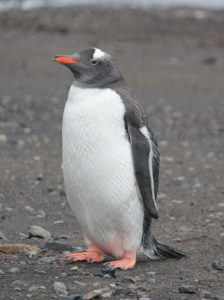
By Steve Ritchie
When I arrived in Ushaia, Argentina last month, I found many Ushaia souvenirs printed with the slogan fin del mundo which can be roughly translated as “end of the world.”
A city of about 80,000 people at the southern tip of South America, Ushaia is definitely remote. It is the southernmost city in the world, in fact. But it is not the end of the world. That would be where I was going.
My ultimate destination was the continent of Antarctica. To get there
I flew to Buenos Aires and then took a charter flight to Ushaia, where I was to board the M.S. Midnatsol, a cruise ship operated by Hurtigruten, a Norwegian company that specializes in polar region travel. Along with 350 fellow passengers, I would cruise in relative comfort across the vertigo-inducing waves of the Drake Passage to the South Shetland Islands and, eventually, to the Antarctic Peninsula.
The trip would not take me to the interior of the Antarctic continent, an area that is only visited by a few hundred people each year, but would allow me to set foot on Antarctica proper. More significantly, I would get to experience this stunning world of ice and snow and see the amazing mammals, birds and sea life of the region from the land and water. I would also get the knowledge and insights of the 10 naturalists and guides on the trip, with 3-4 daily presentations onboard.
To reach our destination, we had to cross the Drake Passage, 500 miles of open sea that is legendary for turbulent conditions. There is no landmass anywhere in the world at that latitude, nothing to slow the winds or calm the swift currents moving where the Pacific and Atlantic Oceans collide. I was hoping for the best but prepared for the worst, armed with motion sickness patches, wristbands, and Dramamine. While the crossing going south was, according to the crew, really “not that bad,” I still got seasick. Coming back was worse, much worse, but I survived.
And the seasickness is a small price to pay to gain access to this forbidding yet awe-inspiring world. Forty hours after setting sail we finally left the Drake Passage behind and arrived at the South Shetland Islands, mountainous and snow-covered volcanic rocks populated by a few hundred people at most and a few million penguins. The latter number is not an exaggeration; the most comprehensive survey of penguins, completed in 2017, put the penguin census at 12 million in Antarctica, mostly in the Antarctic Islands like the South Shetlands and on the Peninsula.

I got my introduction to these social and fascinating creatures on our first landing, which was at Half Moon Bay. Hiking up a few hundred meters from the water brought me to a group, or colony, of penguins. I sat in the snow and watched them, utterly mesmerized by seeing penguins in the wild. Trudging back and forth with their odd gait between their nesting grounds and the sea on “penguin highways,” they were aware of the presence of humans but were seemingly unaffected by it. They just went about their business of building nests, keeping eggs warm and safe, mating, sleeping. Clumsy and slow on land, they turned into sleek, graceful and powerful creatures in the water. I never tired of watching them on any of the landings.Weddle seals, leopard seals, orcas and humpback whales were also spotted frequently, but always from a greater distance than the penguins.
The Midnatsol sailed further south, from Half Moon Bay to Whaler’s Bay on Deception Island to Melchior Island to Danco Island. As we moved closer to the South Pole, the days grew longer and the icebergs and glaciers grew larger. The seascapes were incredible, with the massive chunks of ice casting a netherworld-like blue tone into the vast whiteness.
In Danco Bay I got my first chance to kayak in the icy waters. It was completely exhilarating to paddle around and through the ice, so much so that I kept grabbing for my camera with numb fingers to get photos of the giant ice sculptures as we floated past. The next evening I was on the ship’s deck, bundled from head to toe, as we moved for two hours through a thick fog bank, which would lift enough occasionally to offer glimpses of floating ice on every side. (I later heard the ship captain say this was the scariest moment of the trip for him, and it was memorable for me, too.)

How cold was it? Not as cold as I expected. Although we did experience severe wind, snow and fog, the temperatures were relatively mild, never dropping too far below freezing. There were two sunny days, amazingly clear and bright. While any traveler would be happy to have these conditions, the warmer temperatures in the Antarctic are, of course, part of a disturbing trend. In the past 60 years, Antarctica has warmed more than anywhere else on the planet, with the average temperature increasing by five degrees. On the peninsula temperatures have increased even more.
And it is not just the air temperatures but the water temperatures are climbing, too, and posing a threat to the entire Antarctic ecosystem. In the last decade six times as much ice was lost in Antarctica as in the 1980s. Warming oceans are threatening the tiny shrimp-like krill that abound in Antarctic waters, and the species that depend on them. The Adelie Penguins, which are found only in Antarctica, have declined in number by 70 percent.
Returning home, the images of Antarctica remain with me. It was an incredible journey, with some sobering insights.
It certainly brings a different meaning to fin del mundo.